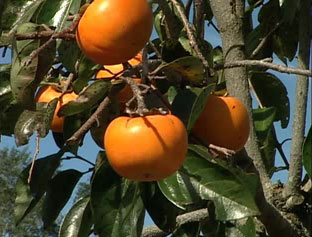Japanese Persimmon
The golden fruits of Japanese persimmon are easy to grow and pack a nutritious punch.
 Characteristics
Characteristics
Japanese persimmons were first introduced to the United States in 1856. By the 1930s, they were widely planted in Florida. Many people still enjoy growing these savory orange fruits, which are high in fiber and vitamins A and C.
The fruits are typically tomato-shaped and can range in size from 1.5 to 4 inches in diameter. Ripe fruits have a smooth texture and mild flavor. In Florida, the fruits generally ripen from late summer through fall.
Japanese persimmons are grouped into two categories: astringent or non-astringent. Astringent cultivars will not have a pleasant flavor unless they are allowed to ripen completely to the point that their flesh becomes soft and almost gelatinous. Non-astringent cultivars can be eaten when fully ripe or while they still have an apple-like crunch.
Both types of persimmons will grow and fruit well in Central and North Florida. In South Florida, gardeners will have best results with astringent types.
One advantage of Japanese persimmon is that is that you don't need to plant multiple trees in order to have fruit. Japanese persimmons also have great fall color and can be trained as hedges or even espaliers.
Left unpruned, the trees can reach 20 to 30 feet tall and spread 15 to 25 feet wide. They are very attractive trees and make great specimen plantings.
Japanese persimmons are known scientifically as Diospyros kaki. The native species D. virginiana can also be grown in Florida, though its astringent fruits are much smaller than those of the Japanese persimmon.
Planting and Care
Plant your Japanese persimmon in full sun in well-drained soil. It's also a good idea to have your soil tested, since the trees prefer a neutral or slightly acidic soil pH.
The trees can withstand short periods of drought, but they will do best with regular watering. Provide water in small but regular doses, either by hand-watering it or by installing a drip irrigation system.
Your persimmon will be relatively undemanding, though it will benefit from some pruning. Following good pruning practices will let sunlight reach more of the tree, allow the leaves dry out after irrigation or rainfall, and make treating for any pest or disease problems easier.
Gardeners may be surprised to see trees drop some of their fruit a few weeks after they bloom, but there is no need to be alarmed. This is just the tree trying to self-regulate its fruit load.
Many times, the biggest problem gardeners have is harvesting the ripe fruits before the birds and other animals begin feasting on them.
For more information on Japanese persimmon, contact your county Extension office.

